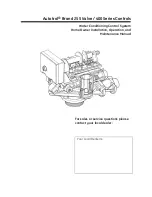
~6~
6. Adjust pool suction and return valves to achieve desired
flow. Check the plumbing and filter for water leaks and tighten
connections, bolts, and nuts, as required.
NOTE: During initial clean-up of the pool water, it may be
necessary to backwash frequently due to the unusually heavy
initial dirt load in the water.
7. Record the pressure gauge reading (start up pressure) during
initial operation. After a period of time, the accumulated dirt
and debris in the filter causes a resistance to flow, and the flow
diminishes. The pressure will start to rise and the flow of water will
start diminishing. When the pressure gauge reading is 50 kPa (7.2
psi) higher than the initial “Start up” pressure, it is time to backwash
(clean) the filter (see Backwashing).
NOTE: If the filter is connected to mains water, it is not necessary
to record the “Start up” pressure, as mains pressure tends to
fluctuate.
BACKWASHING
The function of backwashing is to separate the deposited particles
from filter media grains and flush them from the filter bed.
Backwashing is achieved by reversing the flow of water through the
filter bed at a fairly high flow rate. This high flow rate expands the
filter bed and the water collects the debris taking it to waste.
CONDITIONS FOR BACKWASHING:-
Time for backwashing is determined by the following conditions:
1. The flow rate through the filter bed decreases until it is insufficient
to meet the demand.
2. The removal efficiency of the filter bed decreases to the point
where the effluent quality deteriorates and is no longer acceptable.
3. When the pressure gauge reading is 50 kPa (7.2 psi) higher than
the start up pressure.
4. If the filter is connected to mains water, pressure rise is not an
accurate indicator as mains pressure tends to fluctuate. It is best to
rely on the actual flow rate.
NOTE: We recommends that you backwash a swimming pool sand
filter in a residential installation at least once a month.
IMPORTANCE OF BACKWASHING
The importance of backwashing cannot be overstated. Dense filter
media can become “packed” without proper and frequent enough
backwashing. Debris will remain trapped and create channeling
within the filter bed. This will result in the filter bed exhausting early.
Moreover, if debris is not flushed from the media grains, the filter
bed will become dirtier and dirtier as time goes on until the filter
operation fails.
BACKWASHING INSTRUCTIONS:-
Switch off the Pump/ Close the Inlet Valve.
NOTE: If a pump is installed, switch the pump on and off, instead
of closing and opening the Inlet Valve.
2. Release the filter’s pressure by loosening Pressure Release Valve
until the Pressure Gauge needle drops to zero <0>.
3. Retighten Pressure Release Valve.
PREMIÈRE MISE EN SERVICE
Vérifier que la quantité de sable dans le filtre est conforme
et que tous les raccords sont correctement réalisés.
1. Appuyer sur la poignée de la vanne multivoies et la
mettre en position Backwash.
NOTE: Afin de ne pas endommager le joint de la vanne,
toujours appuyer sur la poignée avnt de la tourner.
2. Ouvrir la vanne d’entrée et démarrer la pompe pour
remplir la cuve d’eau.
PRECAUTION: Toutes les vannes doivent être ouvertes
quand on démarre la pompe.
A défaut, des blessures graves et/ou des dégats matériels
peuvent être provoqués.
3. Quand de l’eau sort de la vanne par la sortie « waste »
(égout ) laisser fonctionner la pompe pendant une minute
environ. Ce lavage initial du sable est recommandé pour
éliminer impuretés et poussières contenues dans le sable.
4. Arréter la pompe et positionner la vanne sur Rinse.
Remettre la pompe en marche jusqu’à ce que l’eau
passant par le voyant de turbidité soit claire (environ 10 à
15 secondes).
5.Arréter la pompe et positionner la vanne sur Filter.
Remettre la pompe en marche. Votre filtre focntionne
maintenant en mode normal. Vérifier les tuyaux et raccords
et éliminer les fuites éventuelles.
NOTE: lors de la première filtration de la piscine, il peut
être nécessaire de faite un lavage à contre-courant
fréquemment en raison de la forte teneur de l’eau en
impuretés.
7. Mémoriser la pression indiquée par le manomètre
(pression initiale). Progressivement, débris et impuretés
accumulés dans le filtre provoquent un colmatage du
sable : le débit diminue et la pression augmente. Quand
la pression aura augmenté de 4 à 7 psi, par rapport à
la pression initiale, il est temps d’effectuer un lavage à
contre-courant (Backwash)
NOTE: Si le filtre est connecté à l’eau du secteur, il n’est
pas nécessaire de mémoriser la pression initiale, la
pression d’eau du secteur étant variable.
LAVAGE À CONTRE-COURANT
Le lavage à contre-courant sert à séparer les particules
accumulées dans le sable et à les évacuer par un procédé
d’inversion de la circulation d’eau.
QUAND PROCÉDER À UN LAVAGE À CONTRE-COURANT :
1. La circulation d’eau dans le sable est devenue
insuffisante pour filtrer correctement.
2. La capacité du sable à retenir les particules a baissé au
point que l’eau revient sale dans le bassin.
3. La pression aura augmentée de 4 à 7 psi.


























